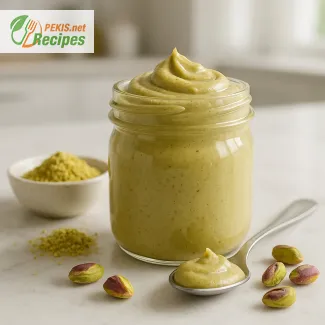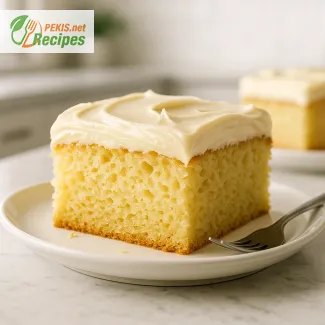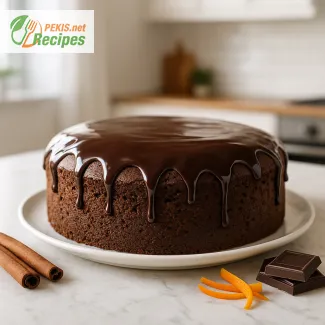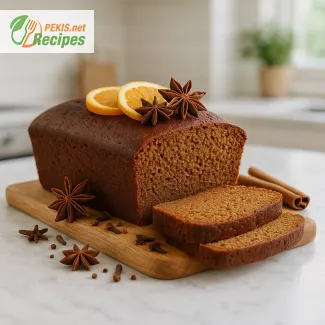Yielding 12 servings with a total time of 180 minutes (40 prep, 50 bake, 90 rise), Traditional Christmas Walnut Potica combines a soft, buttery yeast dough with a rich walnut-honey filling for a golden, festive centerpiece. Its signature spiral layers bring both visual beauty and deep, nutty flavor to the holiday table. Best enjoyed fresh, it stays moist for up to 5 days when wrapped or can be frozen for later celebrations, preserving its aroma of butter, cinnamon, and rum that defines Slovenian Christmas tradition.
Having spent countless holidays perfecting festive pastries, the process of creating Traditional Christmas Walnut Potica feels like preserving a piece of living heritage. Working the soft yeast dough by hand, letting it rise slowly, and spreading the warm walnut-honey mixture fills the kitchen with anticipation and comfort. It’s not only about baking—it’s about rhythm, patience, and a deep respect for the craft that transforms simple ingredients into something celebratory.
PEKIS – professional chef and recipe developer with over 25 years of experience in cooking and baking, specialized in European and international cuisine.
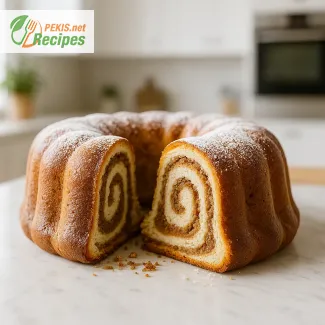
The Heart of Slovenian Festive Baking: Walnut Potica
A luxurious holiday pastry woven with heritage, warmth, and celebration
The comforting aroma of Slovenian Walnut Potica signals that the festive season has truly arrived. With its golden crust, delicate spiral layers of sweet walnuts, and the comforting scent of butter, honey, and vanilla, this pastry embodies everything that makes Christmas magical. Each slice is not only a treat for the palate but also a reminder of the craftsmanship and patience that define traditional holiday baking.
Made from enriched yeast dough, Potica achieves a perfect harmony between softness and richness. The dough is kneaded until silky, allowed to rise slowly, and rolled out thin enough to embrace its sweet walnut filling. Finely ground walnuts blended with sugar, cream, and a touch of rum or honey create a velvety spread that gently perfumes the air while baking. Once removed from the oven, the roll reveals its signature swirl — a mark of celebration and abundance passed down through generations.
From humble origins to a national treasure
The story of Potica traces back to the 16th century, when it first appeared in Slovenian cookbooks as a festive bread for special occasions. Over time, it became a staple of Christmas and Easter, baked in every region, each version carrying its own twist — walnuts in central Slovenia, poppy seeds or tarragon in others. The name itself derives from the word “povitica”, meaning “to roll,” capturing the pastry’s essence. Today, Walnut Potica is a protected symbol of Slovenian culinary heritage, recognized across Europe for its craftsmanship and cultural importance.
Why you’ll love this festive classic
- Aromatic walnut filling that melts into soft, buttery dough.
- Beautiful spiral layers that make every slice a centerpiece.
- Authentic tradition that connects generations through flavor.
- Ideal for gifting or sharing during winter celebrations.
- Endlessly versatile – pairs beautifully with coffee, tea, or mulled wine.
The role of ingredients in perfect balance
The magic lies in the simplicity and quality of each ingredient. Butter adds a rich tenderness, while milk and eggs provide structure and depth. Yeast gives life to the dough, creating lightness, and honey or sugar lends natural sweetness that enhances the roasted aroma of ground walnuts. A whisper of cinnamon or vanilla ties everything together into a warm, festive bouquet that evokes comfort and nostalgia.
Storage and make-ahead preparation
Potica keeps exceptionally well. Once cooled, it can be wrapped tightly in parchment or foil and stored at room temperature for up to five days, retaining its moisture and aroma. For longer preservation, it freezes beautifully — simply slice it, wrap portions, and thaw when needed. Many bakers prepare Potica a day ahead, allowing the flavors of walnuts, honey, and butter to deepen overnight, making it even more delightful the next day.
Explore more holiday inspiration:
For those who love festive baking, discover our other traditional Christmas creations:
- St. Nicholas' Desserts: Recipe for Homemade Fruit Bread
- Gingerbread with Cinnamon – Fragrant, Soft Cookies with Cinnamon and Honey
Creative variations to try
- Honey and raisin Potica: add soaked raisins to the walnut filling for extra sweetness.
- Chocolate swirl Potica: mix cocoa powder into part of the filling for a marbled effect.
- Tarragon Potica: replace walnuts with tarragon, sugar, and butter for a herbal twist.
- Mini Potica rolls: bake in muffin molds for charming individual portions.
- Warm the milk slightly and dissolve the yeast with a teaspoon of sugar. Let it sit for about 10 minutes until frothy.
- In a large bowl, combine flour, salt, sugar, and lemon zest. Add the yeast mixture, egg yolks, and melted butter. Knead until a smooth, elastic dough forms.
- Cover the bowl with a cloth and let the dough rise for 60–90 minutes in a warm place until doubled in size.
- Meanwhile, prepare the walnut filling: mix ground walnuts, brown sugar, honey, cream, rum, and cinnamon until smooth and spreadable.
- Once the dough has risen, roll it out on a lightly floured surface into a rectangle approximately 0.5 cm (0.2 inch) thick.
- Spread the filling evenly over the dough, leaving a small border. Gently roll it into a tight log.
- Grease a Bundt pan (28 cm / 11 inch) with butter and place the roll inside, forming a ring.
- Cover and let rise for another 30 minutes.
- Preheat the oven to 180°C (356°F). Bake for 45–50 minutes until golden brown.
- Allow to cool completely before removing from the pan. Dust with powdered sugar before serving.
FAQ questionHow do I keep walnut Potica from drying out after baking?
To keep Potica soft, let it cool completely, then wrap it tightly in baking paper and afterward in foil or an airtight container. This traps moisture from the buttery yeast dough and prevents the walnut filling from becoming crumbly. Store it at room temperature, not in the fridge. Properly wrapped, it stays fresh for up to 5 days.
FAQ questionCan I prepare Potica dough the day before?
Yes. Prepare the dough, let it rise once, then roll it out, spread the walnut-honey filling, and shape it. Place it in the pan, cover it, and refrigerate overnight. The next day, bring it to room temperature and let it rise again before baking. This slow proofing actually develops better flavor and aroma.
FAQ questionWhy did the filling separate or leak while baking?
This usually happens if the filling is too thin or the dough was rolled too loosely. The filling should be spreadable but not runny, and the roll should be tight so the spiral holds. Also make sure the oven is preheated to 180°C (356°F) so the structure sets early and prevents leaking.
FAQ questionCan I replace walnuts with another nut or filling?
Yes, as long as the texture stays similar. You can use hazelnuts, almonds, or pecans and grind them to the same fineness as walnuts. Keep the same amount of sugar, honey, and cream so the filling stays moist. For a nut-free version, use ground sunflower seeds with cinnamon and honey, but the taste will be milder.
FAQ questionWhat kind of pan is best for baking Potica?
A Bundt or tube pan (28 cm / 11 inch) works best because it distributes heat evenly through the center, helping this richer dough bake through without drying out. Always grease the pan well so the Potica unmolds cleanly and keeps its shape.
FAQ questionWhy is my Potica dense and not airy?
Most often this is due to underproofed dough or milk that was too hot and weakened the yeast. The dough must rise until visibly doubled, and the second rise in the pan is just as important. Use lukewarm milk, knead until smooth, and give it enough time—this is a festive bread, not a quick cake.
Traditional Christmas Walnut Potica brings together everything that defines festive baking — time, care, and the warmth of tradition. Each layer tells a story of heritage and patience, rolled gently into spirals of sweet walnuts, butter, and honey. It’s the kind of dessert that doesn’t just fill the home with aroma but also connects generations through flavor and shared memory.
The combination of rich yeast dough and nut filling creates a perfect balance between softness and texture. Its natural sweetness pairs beautifully with coffee, tea, or mulled wine, making it a highlight of any holiday gathering. When sliced, the golden crust and patterned swirls capture the essence of Slovenian craftsmanship, turning a simple pastry into an elegant celebration.
What makes Potica special isn’t only the ingredients but the process itself — slow rising, gentle rolling, careful baking. Each step builds depth, transforming basic components into a pastry that remains moist, aromatic, and beautifully balanced even days later. It’s a dessert of precision and comfort, a masterpiece that rewards patience with every bite.
Serving Traditional Christmas Walnut Potica means bringing a piece of Slovenia’s culinary soul to the table. Whether enjoyed freshly baked or shared as a holiday gift, its nutty richness and golden texture make it more than a dessert — it’s a festive tradition that continues to inspire both home bakers and professionals around the world.
Allergens present in the recipe:
- Gluten (flour)
- Eggs
- Milk
- Tree nuts (walnuts)
Substitution tips to reduce allergens:
- Replace cow’s milk with almond or oat milk (if not allergic to nuts).
- Use egg replacer or flaxseed gel (1 tbsp flaxseed + 3 tbsp water) for each egg yolk.
- Choose gluten-free flour blend suitable for yeast doughs.
- Replace walnuts with sunflower seeds or pumpkin seeds for a nut-free option.
- Vitamin B2 (mg): 0.18 – supports energy metabolism
- Vitamin E (mg): 1.6 – contributes to cell protection
- Calcium (mg): 45 – supports bone health
- Iron (mg): 1.2 – aids oxygen transport
- Magnesium (mg): 30 – important for nerve and muscle function
- Phosphorus (mg): 90 – helps maintain strong bones
- Potassium (mg): 180 – supports proper heart function
- Polyphenols (mg): 25 – protect against oxidative stress
- Tocopherols (mg): 1.2 – natural antioxidants from nuts
- Flavonoids (mg): 8 – support cardiovascular health
